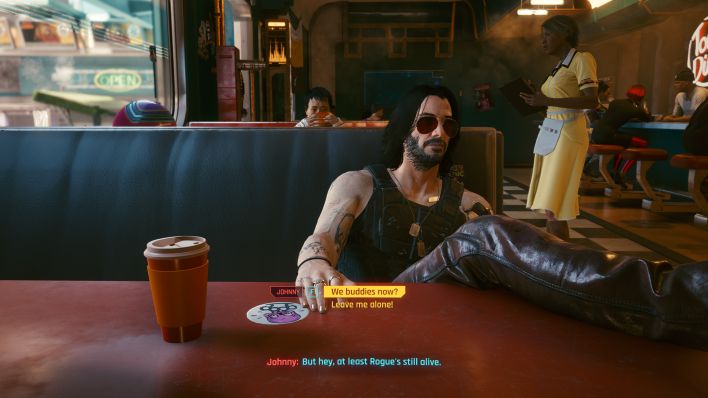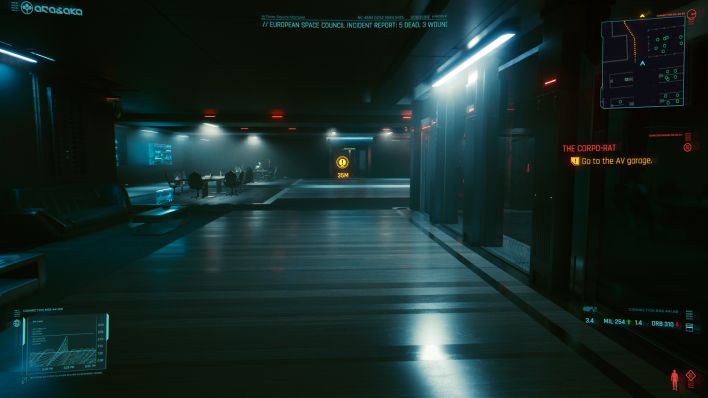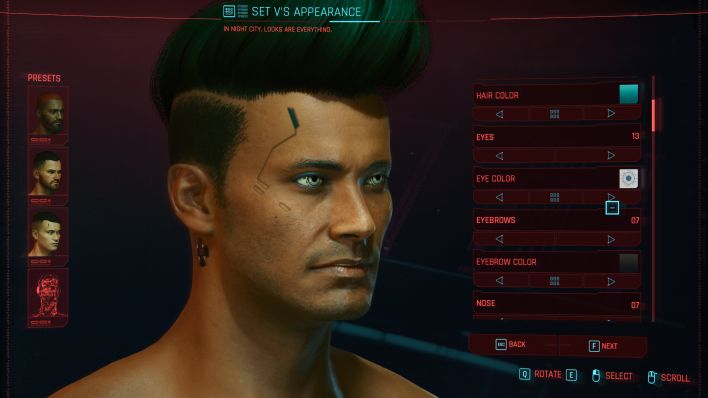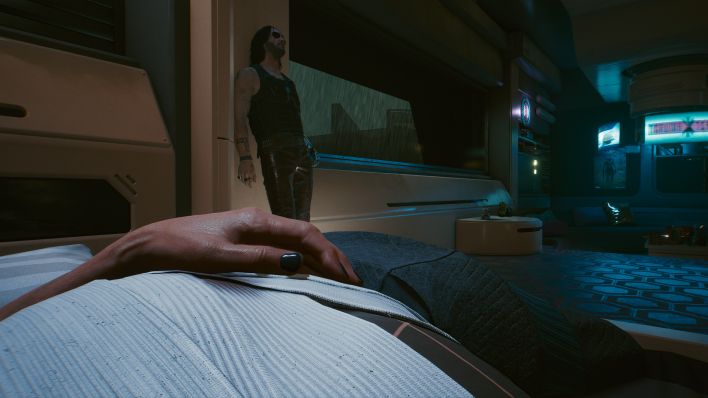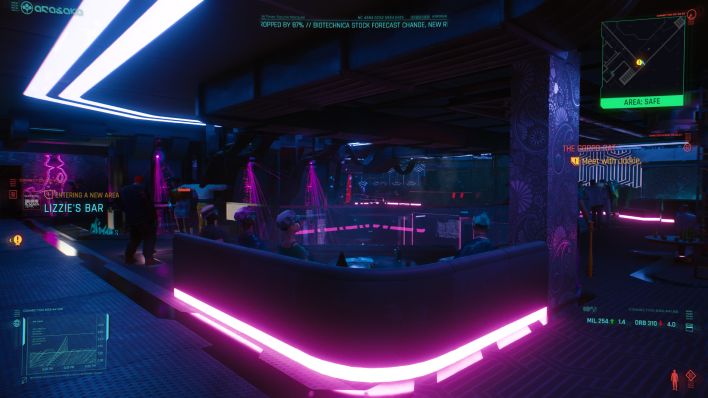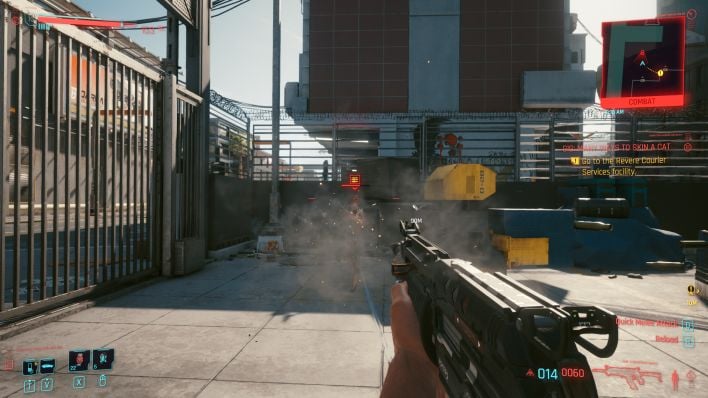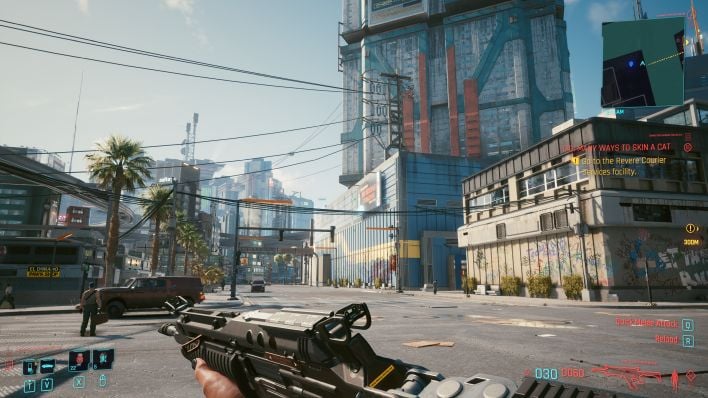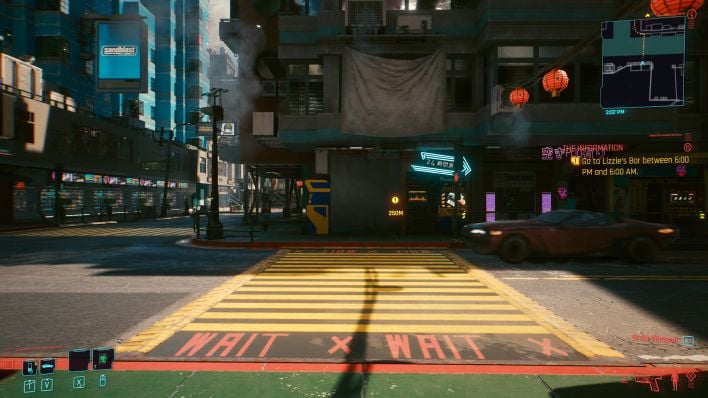Cyberpunk 2077 Review: Gameplay, Performance & Optimization
Cyberpunk 2077: V's Big Adventure Is A Spectacle And Just Plain Fun
Cyberpunk 2077 has been one of the most hotly-anticipated titles in recent memory. Expectations were so high for this title that it's quite possible that CD Projekt Red could never live up to them. After numerous delays, however, Cyberpunk 2077 launched on December 10 to a mix of high praise and mild disappointment from many reviewers. The game is so massive, however, that we elected to take our time to really soak it in before tackling this review.
For those who are new to the franchise, Cyberpunk 2077 is based on the Cyberpunk tabletop role-playing game franchise. The second and fourth editions of Cyberpunk, known as Cyberpunk 2020 and Cyberpunk Red, are probably the most popular variants of the game. The tabletop game was published for the first time in 1988, and the intervening 30-some years have not changed the game world all that much. As a result, Cyberpunk 2077 looks somewhat retro-futuristic, as this is how people in the 1980s imagined what the future would look like. They're probably a little disappointed by how pedestrian actual 2020 looks by comparison.
Immediately, Cyberpunk 2077 was a hit. CD Projekt made back all of its development and marketing costs on the strength of pre-sales alone. As a result, the studio softened the requirements for employee bonus payouts. Despite being available DRM-free from CD Projekt's own GOG game shop, Steam's player counts showed that a million gamers were playing Cyberpunk at the same time almost immediate after its release.
While Cyberpunk 2077 is a hotly anticipated game, it's also a showcase title for NVIDIA's GeForce RTX graphics cards. CDPR applied DirectX Ray Tracing technology liberally to Night City to provide realistic lighting, reflections, and atmosphere. All of the screenshots we're showing in this article have DXR enabled to its highest potential, unless otherwise indicated. As you'll see throughout our review here, the game is a beauty. Eventually all of this eye candy will make its way to AMD's Radeon RX 6000 family of GPUs, but that day is not today. We expect it to happen around the same time as the RDNA2 Xbox Series X and PlayStation 5 get their ports.
The character creation process is Cyberpunk is pretty barebones. For years, other RPG developers have allowed players to really recreate exactly what they wanted. This is accomplished by sliders and two-dimensional grids that adjust facial features with a great degree of freedom. In Cyberpunk 2077, CDPR only gives a list of pre-determined models that reflect different facial features, and there's no fine-tuning at all. This is pretty shallow and not a great start for a role-playing game, as pickier players will have a harder time finding exactly what they want. There are only two voice options, too. This is way behind the 10-year-old Dragon Age: Origins, for example.
Regardless of which origin story you start with, V falls out of favor with their faction and winds up befriending another mercenary named Jackie Welles. Welles and V are part of a team to find a biometric enhancement through a "runner" (a middle manager that introduced mercs to potential clients) named Dex. Jackie and V's heist starts out smoothly enough, but eventually things happen that cause the job to go awry. At the end, V has a biometric implant with a virus with the ghost of Keanu Reeves, and everyone V knew from the first couple hours of the game is dead. This is where the game opens up.
V is now on the clock. The virus contains the personality of dead terrorist Johnny Silverhand, played by the aforementioned Keanu Reeves, and is racing to erase V's personality, using his or her body as a shell for the computerized Johnny. As a result, Johnny goes everywhere with V, and V's internal dialog is replaced with actual dialog with Johnny. Silverhand taunts V at every turn, but figured out early on that it's bad news for him if V dies. The computerized essence of Johnny and V start out working together to figure out how to remove the implant from V's head.
Johnny is the biggest narcissistic jerk you can imagine, but his lines as delivered by Keanu come across a little bored. I suppose we'd be a little bored if we'd been trapped as a personality construct on a glorified SD card for the last 50+ years too. We think this is intentional, since Johnny can be seeing leaning against the wall more than he takes any other pose, and he's just too "cool" to care what anybody thinks. Early on he just wants V dead so he can take over the body, but quickly changes his tune when he realizes the controversy and importance of everything that happened early in the story.
The rest of the cast does a great job, and we couldn't help getting emotionally attached to V's crew and acquaintances. It helps that the story is engaging and the writing is extremely well done. Even though so many characters die early on, each one is a gut punch. We liked these people, and thought they'd be with us for the long haul. And when the next batch of people insert themselves into V's life, we get to know and appreciate them just as much.
That's actually a pretty stark contrast to another science-fiction hacker thriller game that launched this fall, Watch Dogs: Legion. Perhaps it's because there were so many playable characters in Watch Dogs, but each one felt stiff and we had a hard time connecting. The writing wasn't as good and the story wasn't as engaging either. Everything about Cyberpunk's story has been bigger, deeper, and stronger than anything in Watch Dogs Legion. WDL was a fun game, but Cyberpunk went above and beyond with the writing.
The only ding we can make against the story of Cyberpunk is how little our own decisions impact the overall flow of the story. When Johnny first appears, it's apparent that V only has a limited time in Night City before he gives up the ghost, but we can spend all our time running side missions and collecting cars, and he'll never die due to the implant. The closest we get to affecting the story is how we approached the gameplay. Skipping all the optional parts of a story mission makes it harder because we may not have stealth or surprise on our side, but going in guns blazing is just as effective as stealth. We're playing a pretty linear story, albeit an incredibly entertaining one.
Just about everywhere we went had one or more side missions available, which ranged from finding a specific person to interrogate or kill, steal technology, sneak around to gather intel, and a lot more. The side quests themselves do start to get a little repetitive after a while, but each quest giver feels like a real person with their own distinct personality, motives, and desires. The attention of detail in the writing is top-notch, and the side quests reflect it.
Getting around Night City has a diverse set of travel methods. V can drive a car, walk to fast-travel kiosks that allow going anywhere right away, or ride in a Delamain taxi. Walking is also on the table, although it'll take a while. Driving is a little strange, however. When we drove ourselves around, we could switch between a first-person camera, which provides very limited visibility, and a third-person camera where we still had to move the camera with the mouse as we drove. Neither option was very attractive, and we found ourselves fast-traveling an awful lot. Night City is pretty open from the start, and we could fast-travel to areas we'd never visited previously.
Both being open-world games, we feel compelled to draw more comparisons to Watch Dogs Legion. London wasn't nearly as big as Night City, nor as detailed. Cyberpunk's world scales vertically as well as horizontally, as overhead bridges, skywalks, and buildings all tower overhead. It's also very densely populated. The NPCs and vehicles that roam the streets are varied and interesting. At night, the city lives up to its name, as Night City is very dark, wet, and neon.
Another method of combat is in close quarters with fists, knives, or swords. Because Cyberpunk 2077 happens in a city where the Emperor of Japan rules the land, there are some hints of Samurai, and getting a sword is a blast. In one mission, we were stuck deep inside a building when an alarm went off, and the first person we dropped had a katana. And then we had a katana, which feels overpowered until we realized that if someone cut our arm off with a sword, we'd be pretty non-responsive. Perhaps the melee weapons are appropriately weighted in that light. When we could be stealthy, it was tons of fun to hack into our enemies. V has a stamina meter, so just wildly swinging the sword is not advised, but it's super sharp and does a load of damage, so it felt wonderfully freeing in our hands.
Speaking of hacking, all electronics in Cyberpunk 2077 are hackable. Want to blind an enemy? Hack their optics. Want to distract them instead? Make the TV behind them change channels. Want to kill the surveillance system? Hack a computer and turn it off. There's some bad news with this, however: your electronics are hackable, too. It's kind of annoying to see an enemy hacker overheat your implants and cause your skin to burn. Whenever we saw that V was being hacked, whoever was infiltrating had to become top priority to prevent some horrible status ailment from derailing the rest of the fight. Can we spend a few Eddies on a Patch Tuesday upgrade, please?
The only aspect of Cyberpunk's combat that isn't particularly fun in a first-person perspective is the camera system. The game is completely first-person, outside of driving a car. There's no "vanity camera" in Cyberpunk 2077 at all. Once we customized V and got dressed, that was the last we'd see of the clothes, hairstyle, face, and tattoos unless we happened to wander into a bathroom and checked ourselves out in the mirror. Maybe that's a good thing, considering the limited customization options.
More troubling are the magical appearing pedestrians and vehicles. Cyberpunk 2077 was something of a chore to benchmark because the game world is randomized every time we load, and people and cars appear out of thin air. On multiple occasions, we'd look both ways before crossing the street and then suddenly get mashed by a car that appeared right on top of us. As we turn corners, people warp in right before our eyes like they're Protoss Stalkers from StarCraft, and because they're solid objects we suddenly can't walk where we had a clear path a moment earlier.
Those issues are the most aggravating, but others remain. The internet had a field day making fun of the PlayStation 4 and Xbox One versions of Cyberpunk for their low-resolution placeholder textures that eventually get replaced with more details, but the same thing happens on a pretty powerful PC. Texture pop-in is pretty jarring at high resolutions and detail levels, and on our test system with 32 GB of system memory, it's a shame that it happens at all.
Lastly, it seems that Cyberpunk 2077 doesn't make the best use of AMD's CPUs with symmetric multi-threading, including every generation of Ryzen up through Zen 3. One Redditor put together an unofficial binary patch that seems to correct the issue. Because we were testing on AMD CPUs, a Ryzen 7 3700X and Ryzen 9 3900X, we made the decision to enable it. We'll talk more about our testing methods on the next page, but it does make a big difference when Ray Tracing is enabled and the GPU isn't the limiting factor...
For those who are new to the franchise, Cyberpunk 2077 is based on the Cyberpunk tabletop role-playing game franchise. The second and fourth editions of Cyberpunk, known as Cyberpunk 2020 and Cyberpunk Red, are probably the most popular variants of the game. The tabletop game was published for the first time in 1988, and the intervening 30-some years have not changed the game world all that much. As a result, Cyberpunk 2077 looks somewhat retro-futuristic, as this is how people in the 1980s imagined what the future would look like. They're probably a little disappointed by how pedestrian actual 2020 looks by comparison.
Immediately, Cyberpunk 2077 was a hit. CD Projekt made back all of its development and marketing costs on the strength of pre-sales alone. As a result, the studio softened the requirements for employee bonus payouts. Despite being available DRM-free from CD Projekt's own GOG game shop, Steam's player counts showed that a million gamers were playing Cyberpunk at the same time almost immediate after its release.
While Cyberpunk 2077 is a hotly anticipated game, it's also a showcase title for NVIDIA's GeForce RTX graphics cards. CDPR applied DirectX Ray Tracing technology liberally to Night City to provide realistic lighting, reflections, and atmosphere. All of the screenshots we're showing in this article have DXR enabled to its highest potential, unless otherwise indicated. As you'll see throughout our review here, the game is a beauty. Eventually all of this eye candy will make its way to AMD's Radeon RX 6000 family of GPUs, but that day is not today. We expect it to happen around the same time as the RDNA2 Xbox Series X and PlayStation 5 get their ports.
About Cyberpunk 2077
In Cyberpunk 2077, you are V, a mercenary on a clock who has three difference, complex and varied backgrounds. Street Kid V was a gang member who grew up on the streets of Night City, that knows who the kingpins are, and has complicated histories with some of them. The Nomads are outsiders from the badlands, and the Nomad version of V is looking to make a fresh start in Night City. Lastly, Corpo V had a pretty intense corporate job who runs afoul of the very company that employs him (or her) when a hit job goes horribly wrong. We selected Corpo V for our play-through. Beyond playing through the origin story, picking a specific origin gives background-specific conversation options in the game, and can lead to making specific missions easier or more difficult.The character creation process is Cyberpunk is pretty barebones. For years, other RPG developers have allowed players to really recreate exactly what they wanted. This is accomplished by sliders and two-dimensional grids that adjust facial features with a great degree of freedom. In Cyberpunk 2077, CDPR only gives a list of pre-determined models that reflect different facial features, and there's no fine-tuning at all. This is pretty shallow and not a great start for a role-playing game, as pickier players will have a harder time finding exactly what they want. There are only two voice options, too. This is way behind the 10-year-old Dragon Age: Origins, for example.
Regardless of which origin story you start with, V falls out of favor with their faction and winds up befriending another mercenary named Jackie Welles. Welles and V are part of a team to find a biometric enhancement through a "runner" (a middle manager that introduced mercs to potential clients) named Dex. Jackie and V's heist starts out smoothly enough, but eventually things happen that cause the job to go awry. At the end, V has a biometric implant with a virus with the ghost of Keanu Reeves, and everyone V knew from the first couple hours of the game is dead. This is where the game opens up.
V is now on the clock. The virus contains the personality of dead terrorist Johnny Silverhand, played by the aforementioned Keanu Reeves, and is racing to erase V's personality, using his or her body as a shell for the computerized Johnny. As a result, Johnny goes everywhere with V, and V's internal dialog is replaced with actual dialog with Johnny. Silverhand taunts V at every turn, but figured out early on that it's bad news for him if V dies. The computerized essence of Johnny and V start out working together to figure out how to remove the implant from V's head.
Johnny is the biggest narcissistic jerk you can imagine, but his lines as delivered by Keanu come across a little bored. I suppose we'd be a little bored if we'd been trapped as a personality construct on a glorified SD card for the last 50+ years too. We think this is intentional, since Johnny can be seeing leaning against the wall more than he takes any other pose, and he's just too "cool" to care what anybody thinks. Early on he just wants V dead so he can take over the body, but quickly changes his tune when he realizes the controversy and importance of everything that happened early in the story.
The rest of the cast does a great job, and we couldn't help getting emotionally attached to V's crew and acquaintances. It helps that the story is engaging and the writing is extremely well done. Even though so many characters die early on, each one is a gut punch. We liked these people, and thought they'd be with us for the long haul. And when the next batch of people insert themselves into V's life, we get to know and appreciate them just as much.
That's actually a pretty stark contrast to another science-fiction hacker thriller game that launched this fall, Watch Dogs: Legion. Perhaps it's because there were so many playable characters in Watch Dogs, but each one felt stiff and we had a hard time connecting. The writing wasn't as good and the story wasn't as engaging either. Everything about Cyberpunk's story has been bigger, deeper, and stronger than anything in Watch Dogs Legion. WDL was a fun game, but Cyberpunk went above and beyond with the writing.
The only ding we can make against the story of Cyberpunk is how little our own decisions impact the overall flow of the story. When Johnny first appears, it's apparent that V only has a limited time in Night City before he gives up the ghost, but we can spend all our time running side missions and collecting cars, and he'll never die due to the implant. The closest we get to affecting the story is how we approached the gameplay. Skipping all the optional parts of a story mission makes it harder because we may not have stealth or surprise on our side, but going in guns blazing is just as effective as stealth. We're playing a pretty linear story, albeit an incredibly entertaining one.
Cyberpunk 2077 Missions And Structure
As a story-driven role playing game, we don't want to give away much more than that. There's quite a bit more to do in Night City, though. Along with the main storyline, Cyberpunk 2077 has tons of side quests to accomplish from runners all over Night City, quests that stem off the main story missions, and even fetch quests for an AI-run taxi company, Delamain.Just about everywhere we went had one or more side missions available, which ranged from finding a specific person to interrogate or kill, steal technology, sneak around to gather intel, and a lot more. The side quests themselves do start to get a little repetitive after a while, but each quest giver feels like a real person with their own distinct personality, motives, and desires. The attention of detail in the writing is top-notch, and the side quests reflect it.
Getting around Night City has a diverse set of travel methods. V can drive a car, walk to fast-travel kiosks that allow going anywhere right away, or ride in a Delamain taxi. Walking is also on the table, although it'll take a while. Driving is a little strange, however. When we drove ourselves around, we could switch between a first-person camera, which provides very limited visibility, and a third-person camera where we still had to move the camera with the mouse as we drove. Neither option was very attractive, and we found ourselves fast-traveling an awful lot. Night City is pretty open from the start, and we could fast-travel to areas we'd never visited previously.
Both being open-world games, we feel compelled to draw more comparisons to Watch Dogs Legion. London wasn't nearly as big as Night City, nor as detailed. Cyberpunk's world scales vertically as well as horizontally, as overhead bridges, skywalks, and buildings all tower overhead. It's also very densely populated. The NPCs and vehicles that roam the streets are varied and interesting. At night, the city lives up to its name, as Night City is very dark, wet, and neon.
Cyberpunk 2077 Combat In Night City
Cyberpunk 2077 is mostly a first-person game. Combat is full of gunplay and swordplay, and most of the standard first-person shooter tropes apply. That includes looting ammo and weapons off the fresh corpses of our fallen enemies, right-clicking to look down the sights of a gun, and WASD + mouse navigation. Many of the weapons we found felt very satisfying. Pulling the trigger on a shotgun when we were up-close and personal with an enemy rightly left them completely incapacitated.Another method of combat is in close quarters with fists, knives, or swords. Because Cyberpunk 2077 happens in a city where the Emperor of Japan rules the land, there are some hints of Samurai, and getting a sword is a blast. In one mission, we were stuck deep inside a building when an alarm went off, and the first person we dropped had a katana. And then we had a katana, which feels overpowered until we realized that if someone cut our arm off with a sword, we'd be pretty non-responsive. Perhaps the melee weapons are appropriately weighted in that light. When we could be stealthy, it was tons of fun to hack into our enemies. V has a stamina meter, so just wildly swinging the sword is not advised, but it's super sharp and does a load of damage, so it felt wonderfully freeing in our hands.
Speaking of hacking, all electronics in Cyberpunk 2077 are hackable. Want to blind an enemy? Hack their optics. Want to distract them instead? Make the TV behind them change channels. Want to kill the surveillance system? Hack a computer and turn it off. There's some bad news with this, however: your electronics are hackable, too. It's kind of annoying to see an enemy hacker overheat your implants and cause your skin to burn. Whenever we saw that V was being hacked, whoever was infiltrating had to become top priority to prevent some horrible status ailment from derailing the rest of the fight. Can we spend a few Eddies on a Patch Tuesday upgrade, please?
The only aspect of Cyberpunk's combat that isn't particularly fun in a first-person perspective is the camera system. The game is completely first-person, outside of driving a car. There's no "vanity camera" in Cyberpunk 2077 at all. Once we customized V and got dressed, that was the last we'd see of the clothes, hairstyle, face, and tattoos unless we happened to wander into a bathroom and checked ourselves out in the mirror. Maybe that's a good thing, considering the limited customization options.
Cyberpunk 2077 Glitches Remain
Despite multiple delays, Cyberpunk 2077 still feels a little bit rushed. CDPR pushed out the version 1.04 hot fix right after launch, and that version fixed a lot of game-breaking and mission-ending bugs, but still some issues remain. One of the most comical happens right outside of V's apartment. There are some barricades along the street, and the path is so thin that every car passing V's apartment on that side of the street sideswipes the barricades. Those drivers get angry and yell at V like it's somehow our fault that they don't know how to drive.More troubling are the magical appearing pedestrians and vehicles. Cyberpunk 2077 was something of a chore to benchmark because the game world is randomized every time we load, and people and cars appear out of thin air. On multiple occasions, we'd look both ways before crossing the street and then suddenly get mashed by a car that appeared right on top of us. As we turn corners, people warp in right before our eyes like they're Protoss Stalkers from StarCraft, and because they're solid objects we suddenly can't walk where we had a clear path a moment earlier.
Those issues are the most aggravating, but others remain. The internet had a field day making fun of the PlayStation 4 and Xbox One versions of Cyberpunk for their low-resolution placeholder textures that eventually get replaced with more details, but the same thing happens on a pretty powerful PC. Texture pop-in is pretty jarring at high resolutions and detail levels, and on our test system with 32 GB of system memory, it's a shame that it happens at all.
Lastly, it seems that Cyberpunk 2077 doesn't make the best use of AMD's CPUs with symmetric multi-threading, including every generation of Ryzen up through Zen 3. One Redditor put together an unofficial binary patch that seems to correct the issue. Because we were testing on AMD CPUs, a Ryzen 7 3700X and Ryzen 9 3900X, we made the decision to enable it. We'll talk more about our testing methods on the next page, but it does make a big difference when Ray Tracing is enabled and the GPU isn't the limiting factor...

